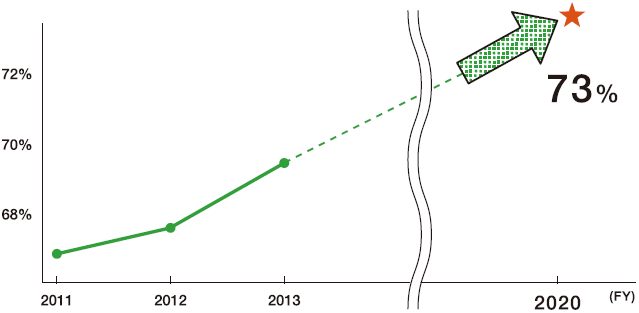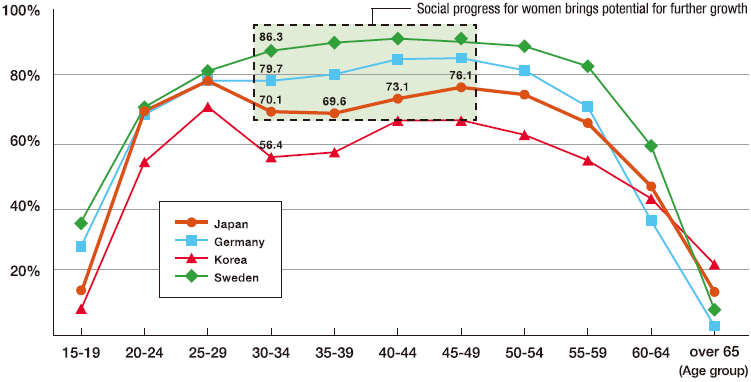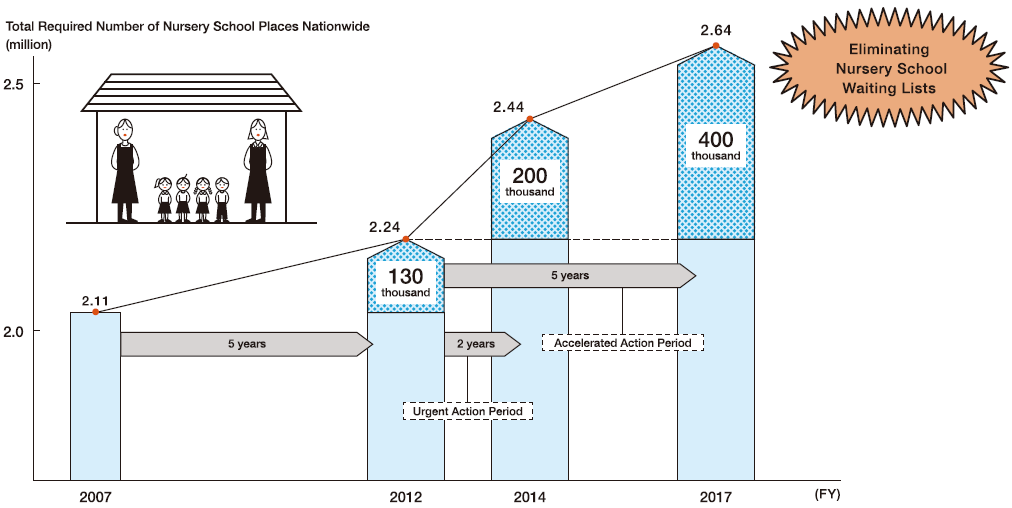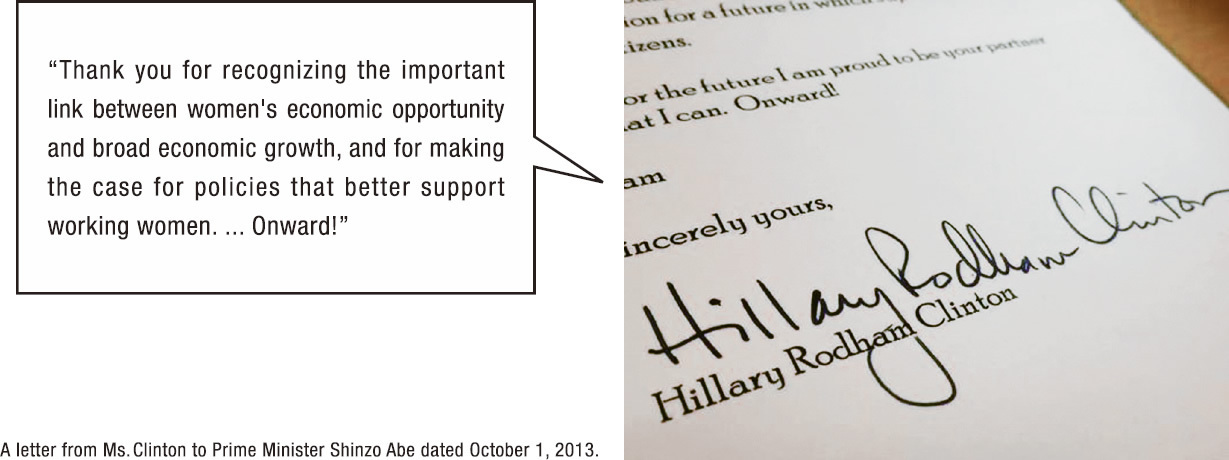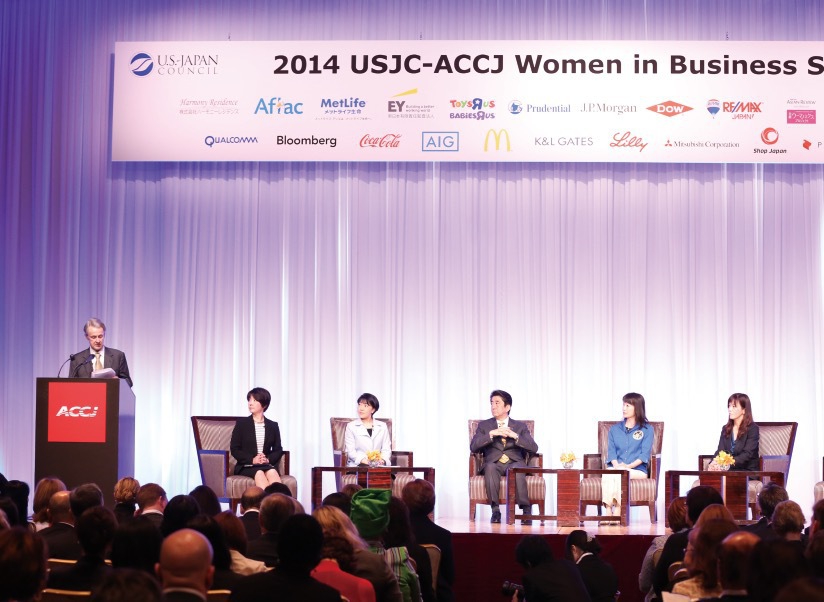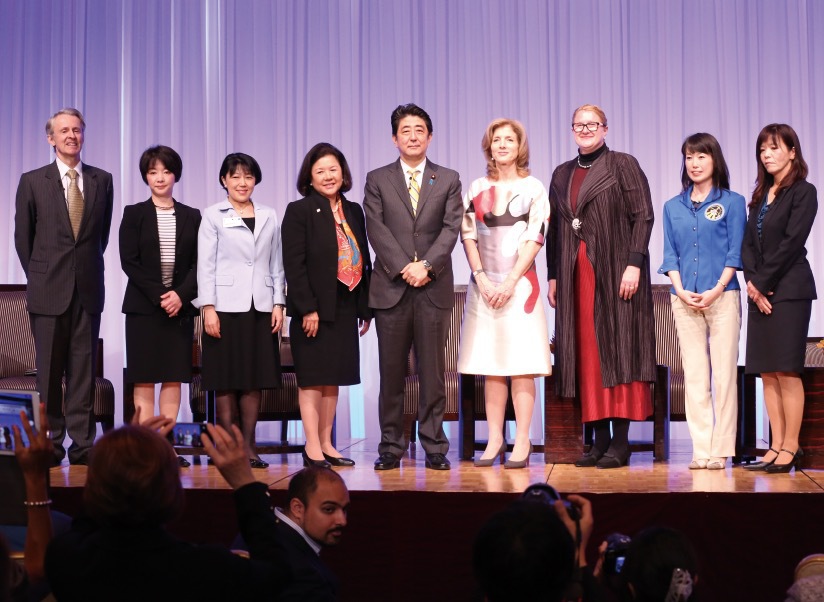“Japan is back!” These were the words of Prime Minister Shinzo Abe, at the New York Stock Exchange on September 25, 2013, displaying his strong determination to return Japan to a central role in the world economy.
Returning to such a core position in the global economy meant lifting the Japanese economy out of deflation through a set of policies known as Abenomics. Prime Minister Abe’s positive strategies for reviving the economy are called the “three arrows” of Abenomics.
The first arrow was bold monetary relaxation and the second was flexible application of fiscal stimulus. As a result of these policies, the Japanese economy has overcome deflation, recording positive real GDP growth for six successive quarters after the Abe administration came into office. Robust corporate performance was accompanied by the highest level of wage increases and annual bonuses in 10 years, demonstrating Japan’s emphatic reemergence onto the world economic stage.
To build a new Japan, the government is now implementing its third arrow, a growth strategy to stimulate private investment. One factor creating some uncertainty as to whether the new Japan can remain strong, however, is the declining birthrate,which is leading to an aging society. As the working population gets smaller, even ifthe economy temporarily recovers its former strength, it may be difficult to maintainmomentum over the longer term. One solution to this problem is “womenomics,” which we introduce in this section.
Compared with other developed countries, Japan has some way to go in promoting active female involvement in the workplace. Through measures to address this, it can increase its growth rate. Data also shows that in some developed countries, high female employment rates are accompanied by high birthrates. Steadily promoting policies that help women to participate more actively in society can bring about economic growth at a time when Japan is struggling with a low birthrate and aging population.
Proportion of Women (Age 25–44) in Work: Trends & Targets
Figures from 2013 show that the proportion of women in work in Japan increased by 1.8% to 69.6% in the period since the government of Shinzo Abe came to power in December 2012, a major improvement on the previous year’s 0.9% increase. The growth strategies laid out in the government ’s Abenomics economic policies are aimed at accelerating this existing positive trend, and the target is to lift the overall figure to 73% by 2020.
*Compiled using figures from Ministry of Internal Affairs and Communications Labor Force Survey 2013. Proportion of women in employment calculated relativeto overall population.
Female Labor Participation Rate:
Age Breakdown & Comparison in International Trends
In comparison to a number of European countries, the high proportion of women in the 30-34 age group who leave work after the birth of their first child produces a distinctive M-shaped curve in Japan. There is significant potential for economic growth in Japan if this trend can be addressed and the proportion of women in their 30’s and 40’s who are employed or seeking work is brought in line with the figures seen in several Western countries.
*Compiled using figures from Ministry of Internal Affairs and Communications Labor Force Survey 2013. International figures taken from International Labour Organization ILOSTAT Database data from 2012. Female labor participation rate calculated relative to overall population, combining number of women in employment with those seeking employment.
Expansion of Preschool Facilities to
Eliminate Nursery School Waiting Lists
In Japan, 2017 is expected to see a peak in the number of children hoping to enter nursery schools. Plans are already underway to ensure that these needs can be met, thereby eliminating instances of children being placed on waiting lists due to a lack of available nursery school places. In the period from 2007 to 2012, the government provided 130,000 extranursery school places to address the shortfall in availability. Urgent action was taken in the two years to the end of fiscal 2014 to increase this figure to 200,000 places. The government aims to boost such action further to ensure that 400,000 additional nursery school places areavailable by the end of fiscal 2017.
Policy Measures
The policies detailed below were announced to promote the active participation of womenas part of the growth strategy. One element is to provide more opportunities for integralinvolvement, while another is to provide strong support to women.
The Abe administration is working to expand female participation in the workforce. It aims to increase the employment rate for women age 25–44 from 68% in 2012 to 73% by 2020, and to increase the percentage of women in leadership positions to 30%.
To ensure that this is more than just a target, Prime Minister Abe is taking every opportunityto push for the selection of women in corporate management positions. At the same time, theAbe administration has consistently been taking the initiative in government, speeding up theappointment of women to positions as high-ranking national public officials. In July 2013, Ms.Atsuko Muraki was appointed to the top bureaucratic position of administrative vice-ministerof the Ministry of Health, Labour and Welfare. And several women have been appointed atthe director-general level. The administration is also working to ensure corporate disclosureof figures regarding numbers of female executives and managers, and has launched a website to make that information public. This will help investors understand the level of female participation at different companies.
The Abe administration is supporting women’s careers in other ways, too. At present, theemployment rate drops dramatically for women in their 30’s with children, as around 60% ofwomen quit their jobs when their first child is born. To reduce that drop in Japan as in otherdeveloped nations, the administration will provide strong support for women raising children.
Specifically, it will provide tax and other incentives to companies that support activefemale participation and a balance between work and family. It will also implement the Planto Accelerate the Elimination of Childcare Waiting Lists, which will establish 200,000 newnursery school places by 2015 and 400,000 by 2018, thus addressing the waiting lists thatnow face parents who cannot find facilities to look after their children.
Additionally, to address the issue of after-school care for elementary school students,particularly those in the first grade, the administration will create 300,000 more places forthem over the next five years.
Furthermore, the government will expand the range of services offered by job centers tomothers who wish to return to work while raising their children. These centers introducejobs allowing a balance between work and family and provide other services aimedspecifically at meeting the needs of mothers. The administration is also advancing subsidyprograms for working mothers, such as by revising the system of incentives to boost trialemployment of new non-regular employees to include mothers who quit full-time positionsto look after their children.
Ms. Christine Lagarde, managing director of the International Monetary Fund, has said that ifJapan were to raise its female labor participation rate to that of most G7 countries (excluding Italy), GDP per capita would rise by 4%. She has also stated that raising the rate further to equal that of Northern Europe would increase GDP per capita by 8%. In a letter to Prime Minister Abe, Ms. Hillary Clinton wrote that if women had the same labor participation rate as men in Japan, GDP would grow by 16%.
Our country is now making rapid progress toward turning those words into reality by creating a Japan where women can shine.































































































































